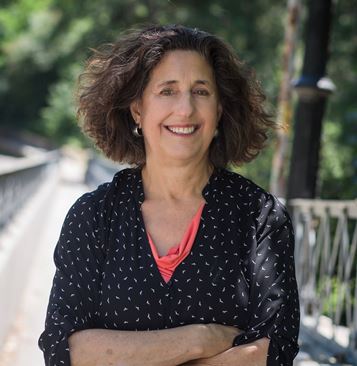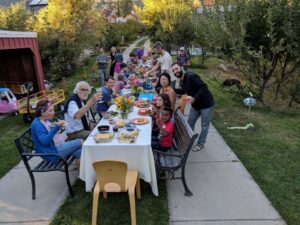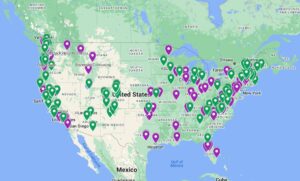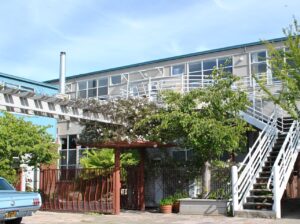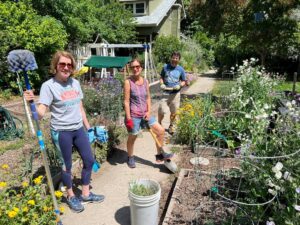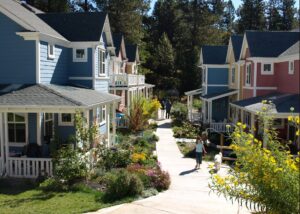This Guest Article for REVITALIZATION is by Katie McCamant.
It’s hard for one family or household to make much of a difference in a neighborhood, but many community-oriented neighbors can make a significant difference. Cohousing residents don’t need fences or gates to keep out the rest of the world, because they welcome community with their immediate and surrounding neighbors.
After studying the housing model in Denmark, I introduced cohousing to the United States in 1988 with my book, Cohousing: A Contemporary Approach to Housing Ourselves (co-authored with Charles Durrett). Thirty plus years of experience and countless communities later, I’ve seen how these developments have the power to truly change lives and neighborhoods for the better.
Cohousing communities consist of private dwellings with extensive common spaces. Shared spaces exist to foster community. They’re managed by the residents, so everyone gets to participate in decision-making and feel valued.
It’s easy to drop a kid off with the neighbors for date night, because people know and trust each other. Not to mention the significant reduction in driving to socialize. People are allowed to age in place with features of universal design, including wider doorways, roll-in showers and lower counters.
Loneliness seems to be the true 21st century epidemic. 51% of mothers with kids feel “serious loneliness,” according to a Harvard Graduate study. I can speculate as to why, but the point is everyone needs support to feel less alone in this world.
Support can mean different things for different people, but when I had a kid on my hip it was a relief to come home to a dinner made by one of my wonderful neighbors, and a community who knew and wanted to play with my daughter while I got to speak with adults.
Over the last 30 years, over 180 cohousing communities have been established in the United States, with another 100 in various stages of formation.
While these communities have been very successful and hold value over time, the housing model has yet to be embraced by professional real estate developers.
Therefore, people who just want to buy into these neighborhoods are forced to put on their developer hat and build cohousing from scratch.
Time after time, these communities get the “undesirable” sites professional developers didn’t scoop up, but you’d never know. Over time, I’ve seen cohousers reinvigorate declining neighborhoods with their passion for sustainability and connection.
People often perceive construction as a nuisance — it’s too loud, it causes traffic, it’s ugly — but it can be a great sign for the surrounding neighborhood. New construction means people still see an area worth investment. New investments help local economies flourish.
But neighborhoods also need people to invest their time and energy, to live “local” not just drive into a garage and never really be part of the neighborhood.
That’s why cohousers are a great addition to any neighborhood. These communities attract community-oriented people who care not just about their own housing community, but the larger neighborhood, getting involved in local schools, organizations and government. Some of my former clients became mayor or city council members after move-in.
Doyle Street Cohousing was the first market-rate housing built in Emeryville, California since the 1960s. My family moved in after construction completed in 1992, and we stayed for 12 years before we moved to the Sierra Foothills and created a new community there. As young architects with little money, our first step was not to draw plans, but rather to find others who would want to live in community at Doyle Street Cohousing.
Instead of seeking investors, we sought future buyers so we could prove there was a market for this kind of intentional neighborhood. Those future residents funded and participated in the design and development process so we could test out ideas about what brought value with real buyers.
The community of 12 condominiums was retrofitted from an old warehouse, which felt like a way for our group to breathe new life back into the small industrial town of Emeryville. Some neighbors, however, weren’t so keen.
Doyle Street Cohousing got through preliminary plan reviews with strong support from City staff, but a small group of angry neighbors presented their concerns on the night of the planning commission meeting. They feared new density and overflowing parking, which led to the Planning Commission denying approval of our plans.
Over the next several weeks, we met with every concerned neighbor and City Council Member, so we were ultimately able to win project approval on appeal. One tactic that changed our discussions with the City and neighbors, was showing people we were future residents, not some developer making a profit and moving on.
New cohousing in Emeryville helped revitalize the neighborhood by providing additional customers and security for nearby small businesses, despite its early opposition.
Former mayor of Emeryville, Nora Davis, said Doyle Street Cohousing played a big part in turning the whole town around. “The residents are particularly good citizens. They participate in local issues. One resident ran for and won a seat on the school board.”
That member became the President of the school board, serving for over ten years and leading a major turnaround for the local school district. Another Doyle Street Cohousing resident won a seat on City Council before she became mayor. The community also hosts the annual community garden organization meeting, and other local organizations in their common house.
As a young mother, buying my first home, I would have had concerns about buying a single home in this neighborhood when we moved in. Living in community felt safe without security gates because we looked out for each other and participated in the larger neighborhood.
Southside Park Cohousing inspired a similar neighborhood revitalization. In the early 1990s, this cohousing group decided to go after a property the Redevelopment Agency was putting out for proposals in downtown Sacramento, California.
At the time, no new housing had manifested downtown for decades. In fact, there were a couple of drug houses on the property. The cohousing group hired my firm to work with them on the design. Even with a reputation of street crime and rampant drug use, the group didn’t build tall fences to keep out non-residents.
They discovered cohousing effectively deters crime because it acts like a ‘Neighborhood Watch.’ Neighbors who know each other watch out for their community. Many avoid urban areas because they’re associated with nefarious activity, but communities like Southside Park Cohousing make urban living safer and more comfortable for people of all ages.
Perhaps more importantly, Southside Park Cohousing residents got involved in the local neighborhood. Partnerships with local organizations improved the larger neighborhood in a way that worked for existing residents, making it better for everyone. Advocacy for a community center to serve the larger neighborhood was one of the early efforts made by Southside cohousers.
When the community moved in 1993, they could not get appraisals to support the cost to build their relatively modest new homes. Today, people find it hard to believe this gem is quietly tucked into the historic neighborhood. Much larger and denser housing developments are now being built all around the downtown core.
People still imagine the American dream as a large single-family home surrounded by private gardens, but a private house can be an expensive to maintain with today’s smaller households. In addition, the key to reducing climate change lies with dense, urban projects.
Cohousing still offers privacy in the home, but it requires less resources and driving. With more small households than ever before (singles living alone comprise the fastest growing housing type in the U.S.), we need housing models to encourage collaboration with neighbors, not just houses crammed closer together.
Sometimes the challenge lies not in the neighborhood, but the land itself. Nevada City Cohousing was completed in 2006 on a former hydraulic mining site from the 1800s gold rush in Nevada City, California.
In addition, the property was adjacent the old city burn dump, which was closed and capped in the 1970s. While the property was walkable to restaurants and shops in downtown, the brownfield was undeveloped because of these complications.
As Nevada City Cohousing’s developer and a future homebuyer, once the property was under contract we needed to determine the clean up required to make the site habitable. Working closely with a local environmental firm, we discovered the issue was more lead and zinc from the burn dump than mercury from gold mining.
Given its history, you might imagine homebuyers would be skeptical of buying such a property, but the cohousing group formed a committee to oversee the cleanup with me (along with environmental consultants) and attest to its success before we started construction.
Today, Nevada City Cohousing is a neighborhood of 34 homes, a shared common house with a large dining area, kids’ playroom and guest rooms, along with a pool and extensive gardens.
By clustering the homes on less than four of our eleven acres, we were able to work cost effectively with the ravines and cobble piles left from mining. With residents ranging from the age of 1 to 80+, we are continuously rebuilding the soil.
We are planting more native plants, restoring waterways, and studying how best to work with our ‘back six’ acres of forest as we adapt for climate change and increasing forest fires. Several Nevada City Cohousing neighbors recently collaborated to find funding and install electric vehicle chargers for the community.
We’ve also learned we live near what was a thriving Nisenan village before the gold miners arrived. This past year, we held a study group to learn about the indigenous people who lived here for over 3,000 years before miners abruptly destroyed their people and way of life.
Our modern village has cleaned up a brownfield and created vibrant and active neighborhood better adapted for forest fires, climate change and changing demographics.
More recently, we’ve seen how cohousing communities are the only new, small, for-sale homes being built. Most towns and cities across the country would benefit from infill condominium developments that offer homeownership opportunities within urban areas.
Unfortunately, liability issues and financing difficulties make it hard to find developers building this type of housing. You are much more likely to find tall, three and four-story townhomes or large rental projects built by out-of-town developers.
Cohousing communities focus on the real needs of people, and are now often the only new developments meeting the need for small, for-sale homes.
Two of my current California clients, Washington Commons with 35 condos in West Sacramento, and Mission Peak Village with 32 condos in Fremont, are good examples of neighborhood-friendly condominium developments with homes ranging from 600 sf to 1300 sf.
Community amenities include bike parking, laundry facilities and exercise rooms, along with social space and guest rooms to make a small condominium more comfortable. Shared outdoor gardens and decks allow everyone in the community to access nice outdoor space, even in an urban building.
Both communities are building in neighborhoods primarily consisting of rentals. Our new cohousing homeownership opportunities help diversify and stabilize these larger neighborhoods.
Cohousing’s true value lies in connected community, which I’ve established cannot be measured by the perfect neighborhood or development site. By attracting people interested in community, cohousing revitalizes existing neighborhoods and creates more resilient housing adapted for climate change, while using less resources.
A sampling of people living in cohousing show high level of involvement in local non-profits, schools, government and environmental organizations. Residents are often more aware of regional news and events because of information shared between neighbors. The sharing of skills and expertise among neighbors mean these communities are continually adapting to become more resilient, whether they support a neighbor with a little childcare or plan for more solar panels.
And yet, without more qualified professionals and developers to work with community seekers, new cohousing developments will never be built in the numbers needed to meet demand or address changing housing needs.
In the interest of expanding the cohousing movement in North America, I launched the 500 Communities Program in 2015. The year-long, virtual course allows professionals in related fields to learn best practices honed over the last 30 years for cohousing development process. To learn more, check out our website.
Erin Harris assisted in the writing of this article.
Unless otherwise credited, all images are courtesy of CoHousing Solutions.
About the Author:
 Katie McCamant has 35 years of experience as a developer, architect and cohousing resident. Coauthor of Cohousing: A Contemporary Approach to Housing Ourselves, the book that introduced cohousing to North America, and more recently, Creating Cohousing: Building Sustainable Communities, Katie co-founded McCamant & Durrett Architects/The CoHousing Company with Charles Durrett, and, more recently, Creating Cohousing: Building Sustainable Communities, Katie co-founded McCamant & Durrett Architects/The CoHousing Company with Charles Durrett.
Katie McCamant has 35 years of experience as a developer, architect and cohousing resident. Coauthor of Cohousing: A Contemporary Approach to Housing Ourselves, the book that introduced cohousing to North America, and more recently, Creating Cohousing: Building Sustainable Communities, Katie co-founded McCamant & Durrett Architects/The CoHousing Company with Charles Durrett, and, more recently, Creating Cohousing: Building Sustainable Communities, Katie co-founded McCamant & Durrett Architects/The CoHousing Company with Charles Durrett.
Katie started CoHousing Solutions as a development consulting firm to share best practices and systems for successful collaborative development. She works with urban, suburban and rural communities all across North America to help them define and implement their development strategy, and build the professional team they need.
Katie also founded the 500 Communities Program to train other professionals to work in this realm. She lived for 12 years at Doyle Street Cohousing in the San Francisco Bay Area, and now lives at Nevada City Cohousing in the Sierra Foothills.

